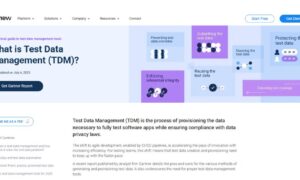Key Takeaways:
- A meticulous data management system is indispensable for regulatory compliance across industries.
- Technological advancements have transformed data management systems into proactive compliance anticipation and risk management tools.
- Integrating regulatory data management into business practices is critical to operational efficiency and competitive edge.
Table of Contents
- Data Management’s Role in Regulatory Frameworks
- Analyzing the Regulatory Environment
- Transformative Power of Modern Data Systems
- Risks of Ignoring Regulatory Compliance
- Practical Features of Top Data Management Tools
- Strategies for Implementing Data Solutions
- Securing the Sanctity of Regulatory Data
- Illustrations of Successful Compliance Strategies
- The Future of Data Management and Compliance
1. Data Management’s Role in Regulatory Frameworks
Compelling regulatory data management lays the bedrock for a company’s risk management strategy. In today’s fast-paced digital economy, organizations must employ dynamic systems that can respond to current regulatory demands and adapt to future changes with agility.
The importance of these systems resonates across all sectors subject to regulatory oversight. In the realm of healthcare, data integrity and traceability are paramount. Effective data management systems deliver accuracy and transparency, crucial for patient safety and trust, and meet regulatory requirements. Within the finance sector, compliance with anti-money laundering (AML) and combating the financing of terrorism (CFT) regulations can only be assured through meticulous monitoring and reporting of financial activities; all these processes are data-driven and must be managed judiciously to ensure integrity and regulatory conformance.
2. Analyzing the Regulatory Environment
Regulatory landscapes are not static; they evolve in response to changes in societal norms, technological advancements, and political influences. To navigate this flux competently, businesses must understand the specific regulations applicable to their industry.
A nuanced grasp of these regulations allows for custom-tailoring data management platforms, making them fit for compliance purposes and a catalyst for business efficiency and innovation.
For instance, pharmaceutical companies operate in a domain where therapeutic breakthroughs and safety scrutiny unfold rapidly, necessitating an adaptive approach underpinned by robust regulatory data management systems to ensure timely compliance.
In data protection, laws such as the General Data Protection Regulation (GDPR) in the European Union and the California Consumer Privacy Act (CCPA) in the United States have set new privacy and data security benchmarks, pressuring companies to elevate their data governance standards.
A data management system that is mindful of such legal nuances can offer organizations the assurance they need to operate confidently in an international business environment, meeting and often exceeding the expectations of both regulators and consumers.
3. Transformative Power of Modern Data Systems
Contemporary data management systems transcend beyond mere storage capabilities. They have evolved into versatile tools capable of delivering advanced data analytics, offering automated reporting, and facilitating enterprise-wide data transparency. By accurately decoding data patterns and extrapolating the potential implications of regulatory changes, these systems enable decision-makers to anticipate compliance requirements, thus allocating resources more effectively and reducing the risk of violations.
The comprehensive insights these systems provide can enhance risk management protocols, augment strategic planning, and fortify an organization’s approach to regulatory adherence. Moreover, integrating disparate data sources into a singular, coherent platform minimizes the chances of discrepancies. It paves the way for a unified and strategic regulatory response across all facets of an enterprise.
4. Risks of Ignoring Regulatory Compliance
When companies underestimate the gravity of regulatory compliance, they open themselves up to a slew of legal and financial hardships. From punitive regulatory fines to class-action lawsuits and loss of licensure, the cost of non-compliance can be catastrophic.
This risk is not limited to monetary consequences—it can also influence a company’s market reputation, potentially leading to customer attrition and reduced investor confidence.
However, an astute data management system can be a preventive mechanism against such unfavorable outcomes. With resources like Forbes’s insights on data and compliance, organizations can recognize data’s critical role in meeting regulatory benchmarks.
By strategically using data management systems, businesses are better equipped when auditors knock on the door, facilitating a smoother audit process with readily available evidence of compliance.
5. Practical Features of Top Data Management Tools
Exceptional data management tools set themselves apart through features that foster adaptability, uncompromised security, and user-friendly interfaces. Automated workflow capabilities reduce the burden of manual processes, audit trails provide transparency, and the ability to update information in real-time is critical for maintaining data integrity. Such features are indispensable in a landscape where regulatory obligations can shift without warning.
Leading platforms offer additional advantages, such as seamless integration with existing enterprise software, customizable reporting options, and multilingual support, catering to the global nature of modern businesses. Organizations that opt for such advanced tools can better manage their risks, streamline compliance processes, and maintain their competitive edge.
6. Strategies for Implementing Data Solutions
Integrating a data management system into an organization’s workflow is a strategic process that calls for careful planning and execution. It is crucial to select a system that aligns with the business’s unique needs and ensure it can be scaled up as the company grows and regulatory demands evolve.
Following a thorough system implementation, periodic updates, user training, and maintenance become essential to keep the system current and effective.
Tailoring these systems to align with specific industry requirements and incorporating feedback from various organizational departments can optimize their functionality. Meticulous planning and a phased implementation can lower the risk of disruptions to daily operations, making the transition to a new or upgraded system as seamless as possible.
7. Securing the Sanctity of Regulatory Data
Data security is an imperative component of regulatory data management, and a breach could compromise the entire compliance operation. Systems must employ state-of-the-art encryption standards, rigorous access controls, and consistent security audits to thwart external threats.
As McKinsey & Company’s discussion on data momentum highlights, strong data governance is not just a regulatory requirement but a pillar of sustainable competitive advantage.
Adopting a layered security approach or ‘defense in depth’ is the hallmark of a resilient data management system. This methodology mitigates the impact of potential breaches by stacking multiple security controls, thereby insulating core data and preserving the integrity of information crucial for regulatory compliance purposes.
8. Illustrations of Successful Compliance Strategies
Examining the experiences of companies that have mastered regulatory compliance through data management can reveal powerful strategies and tools. Success stories provide a blueprint for constructing solid frameworks that prevent breaches, ensure the seamless flow of information, and maintain compliance with various regulatory standards.
Companies can glean insights into adopting technologies and methodologies conducive to an efficient and secure data management ecosystem through case studies.
Emulating the success of these organizations can empower companies to develop robust compliance infrastructures, harnessing the potential of their data to not only satisfy regulatory requirements but also to foster innovation and drive business growth.
9. The Future of Data Management and Compliance
As we march towards a digital future, the data management discipline continues to evolve, with new technologies and methodologies emerging to address regulatory compliance challenges.
The integration of artificial intelligence and machine learning, for example, offers the potential to automate complex compliance tasks, predict regulatory trends, and unearth insights from extensive data sets with unprecedented speed and accuracy.
Businesses at the forefront of these developments can expect to navigate the compliance landscape with greater confidence and foresight. By leveraging cutting-edge data management solutions, they empower themselves to keep pace with regulatory changes and use these changes as catalysts for continued innovation and operational excellence.



































